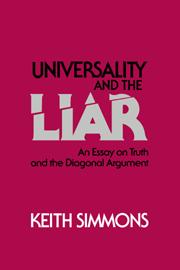Book contents
- Frontmatter
- Contents
- Preface
- Chapter 1 The Liar paradox
- Chapter 2 The diagonal argument
- Chapter 3 The diagonal argument and the Liar, I
- Chapter 4 The diagonal argument and the Liar, II
- Chapter 5 A medieval solution to the Liar
- Chapter 6 A singularity solution to the Liar
- Chapter 7 A formal account of singularities
- Chapter 8 Applications and further singularities
- Chapter 9 Semantic universality
- Notes
- Bibliography
- Index
Chapter 2 - The diagonal argument
Published online by Cambridge University Press: 19 October 2009
- Frontmatter
- Contents
- Preface
- Chapter 1 The Liar paradox
- Chapter 2 The diagonal argument
- Chapter 3 The diagonal argument and the Liar, I
- Chapter 4 The diagonal argument and the Liar, II
- Chapter 5 A medieval solution to the Liar
- Chapter 6 A singularity solution to the Liar
- Chapter 7 A formal account of singularities
- Chapter 8 Applications and further singularities
- Chapter 9 Semantic universality
- Notes
- Bibliography
- Index
Summary
There are arguments found in various areas of mathematical logic that are taken to form a family: the family of diagonal arguments. Much of recursion theory may be described as a theory of diagonalization; diagonal arguments establish basic results of set theory; and they play a central role in the proofs of the limitative theorems of Gödel and Tarski. Diagonal arguments also give rise to set-theoretic and semantic paradoxes. What do these arguments have in common: What makes an argument a diagonal argument? And to ask a question first raised by Russell, why do some diagonal arguments establish theorems, while others generate paradoxes?
In this chapter, I attempt to answer these questions. In Section 2.1, Cantor's original diagonal arguments are described. A general analysis of the diagonal argument is present in Section 2.2. This analysis is then brought to bear on the second question. In Section 2.3, I give an account of the difference between good diagonal arguments (those leading to theorems) and bad diagonal arguments (those leading to paradox). In an appendix, I discuss various extensions of our analysis of the diagonal argument.
CANTOR'S USE OF THE DIAGONAL ARGUMENT
In 1891, Cantor presented a striking argument that has come to be known as Cantor's diagonal argument. One of Cantor's purposes was to replace his earlier, controversial proof that the reals are nondenumerable. But there was also another purpose: to extend this result to the general theorem that any set can be replaced by another of greater power.
- Type
- Chapter
- Information
- Universality and the LiarAn Essay on Truth and the Diagonal Argument, pp. 20 - 44Publisher: Cambridge University PressPrint publication year: 1993



